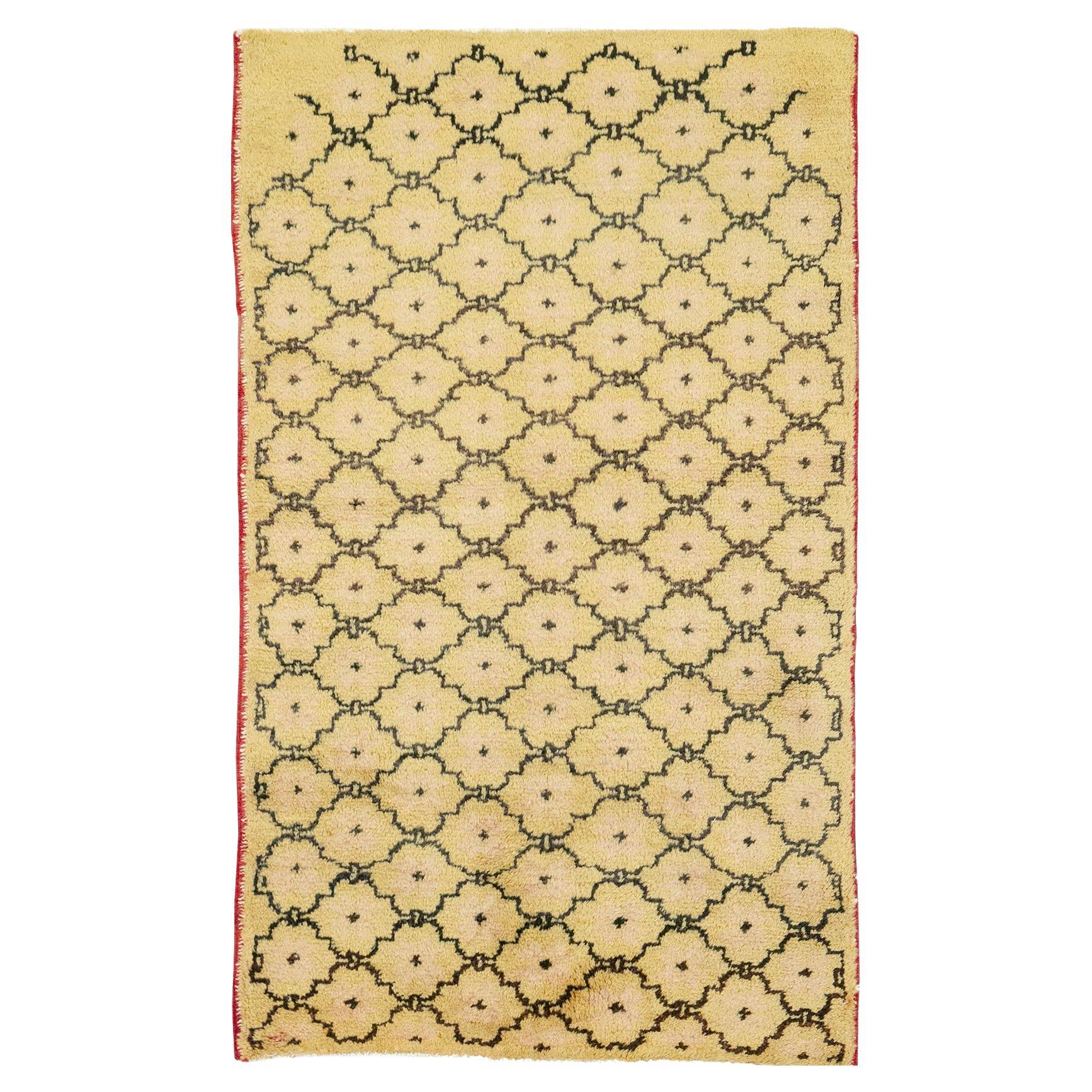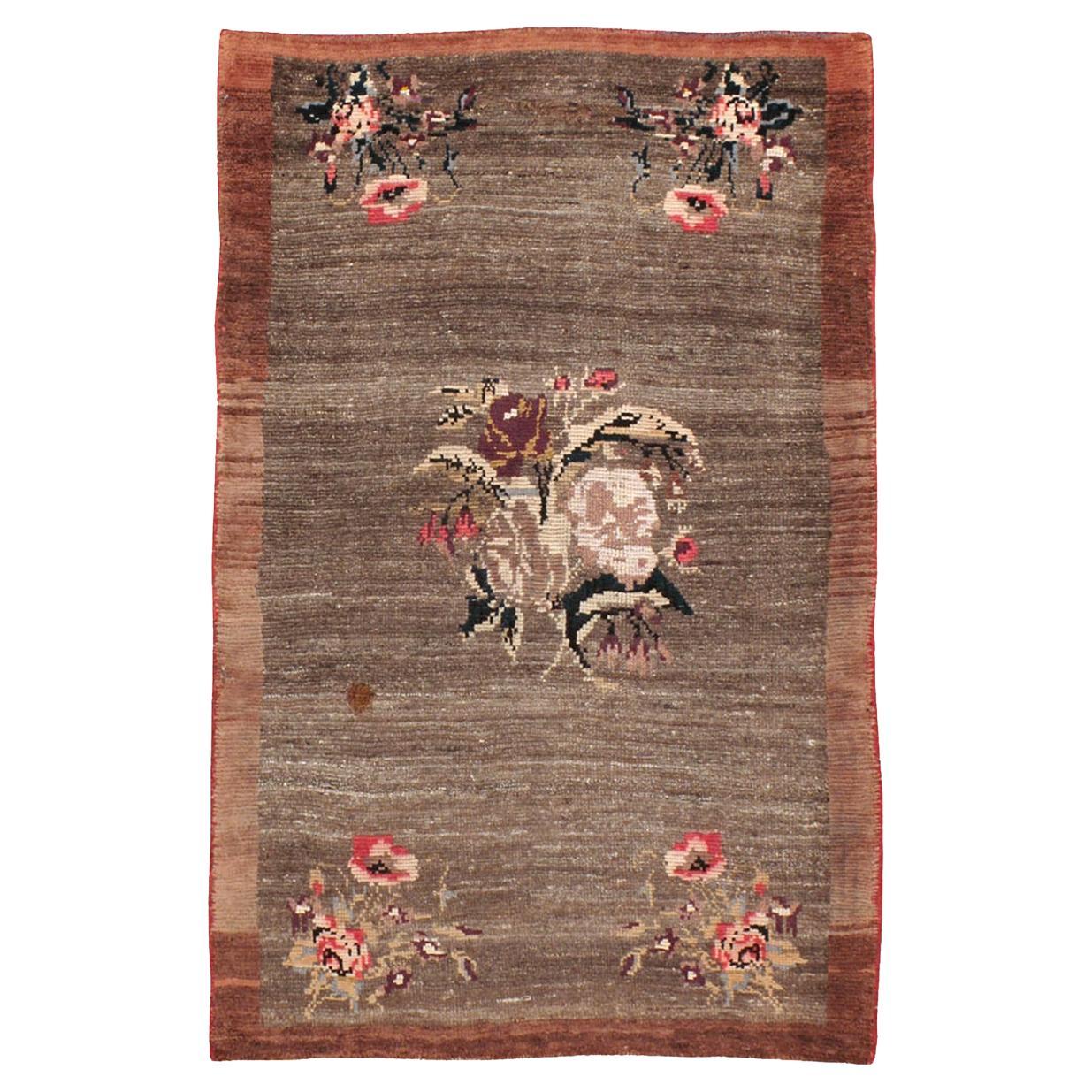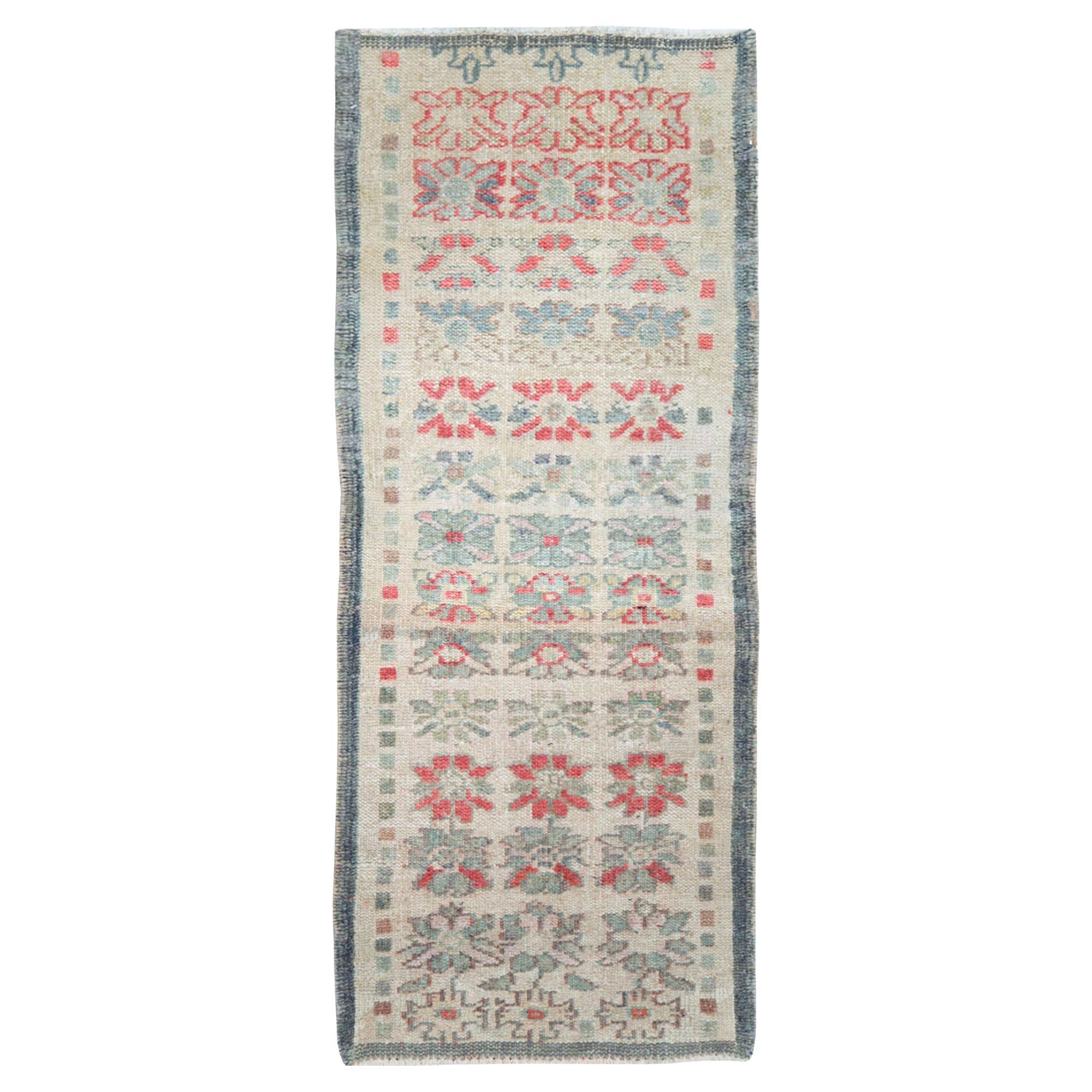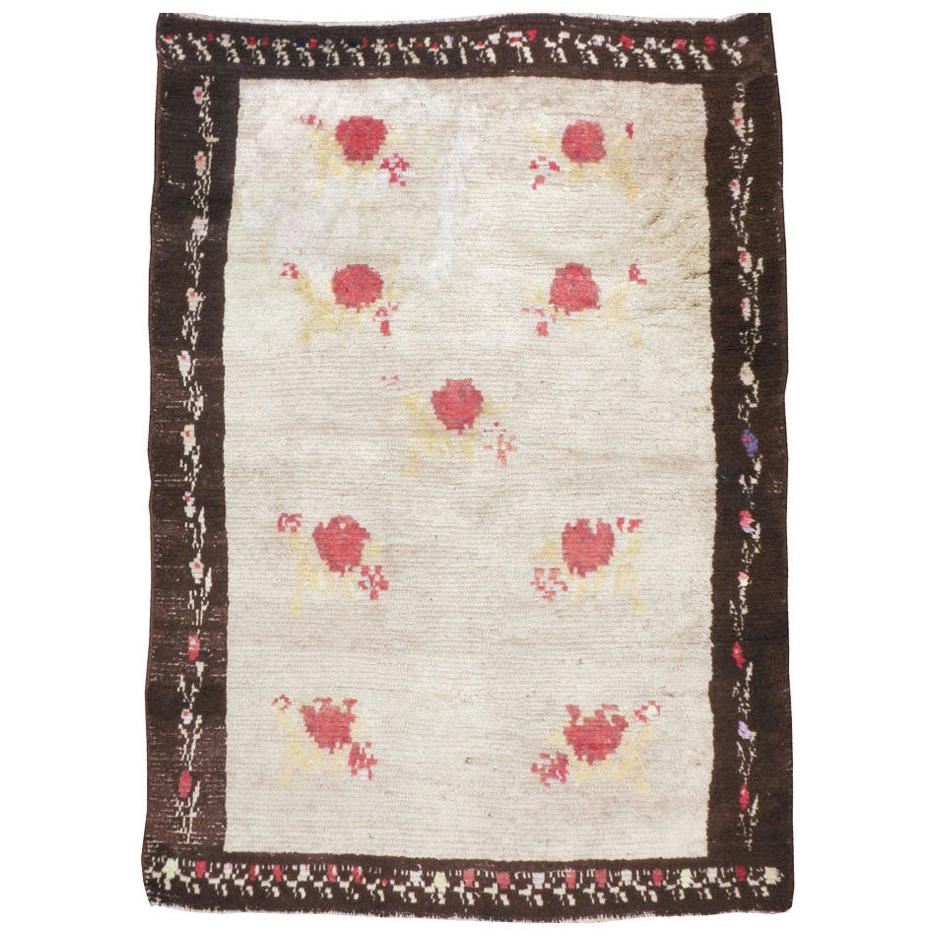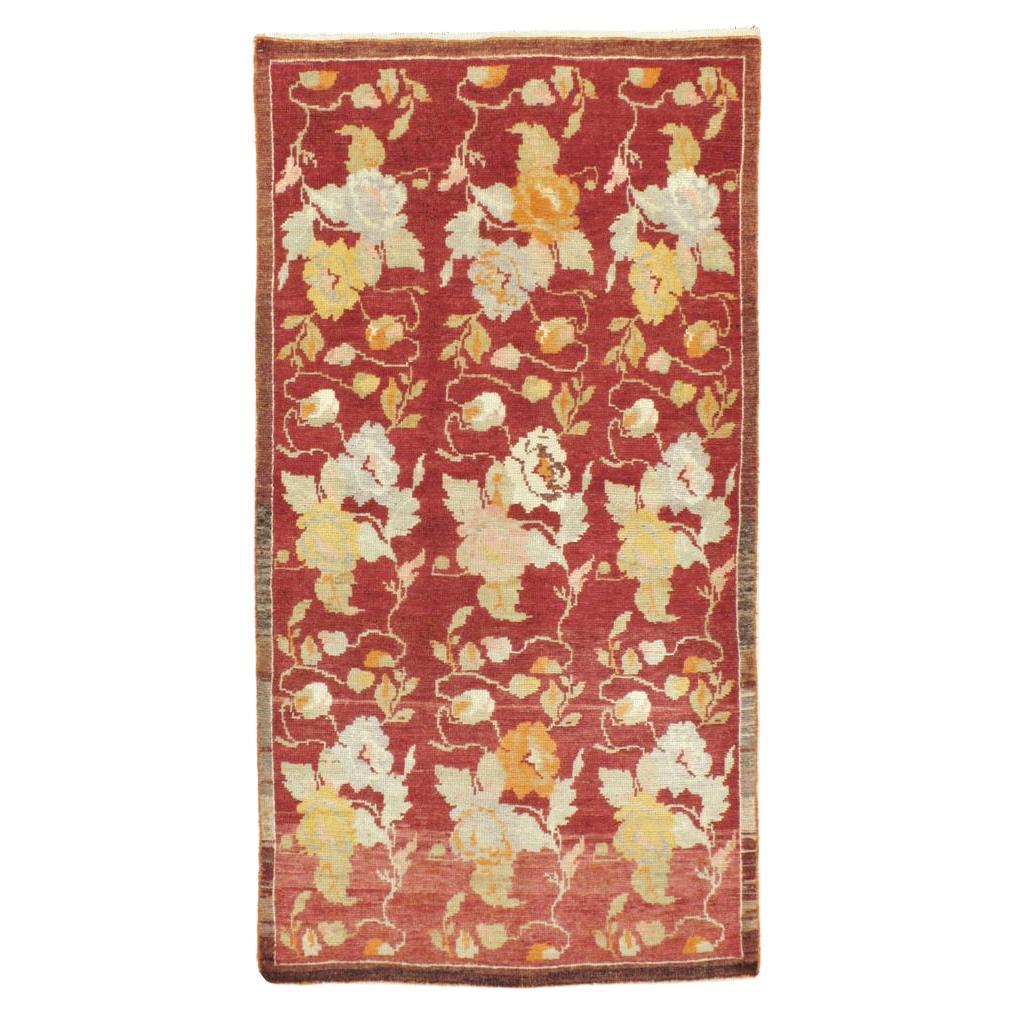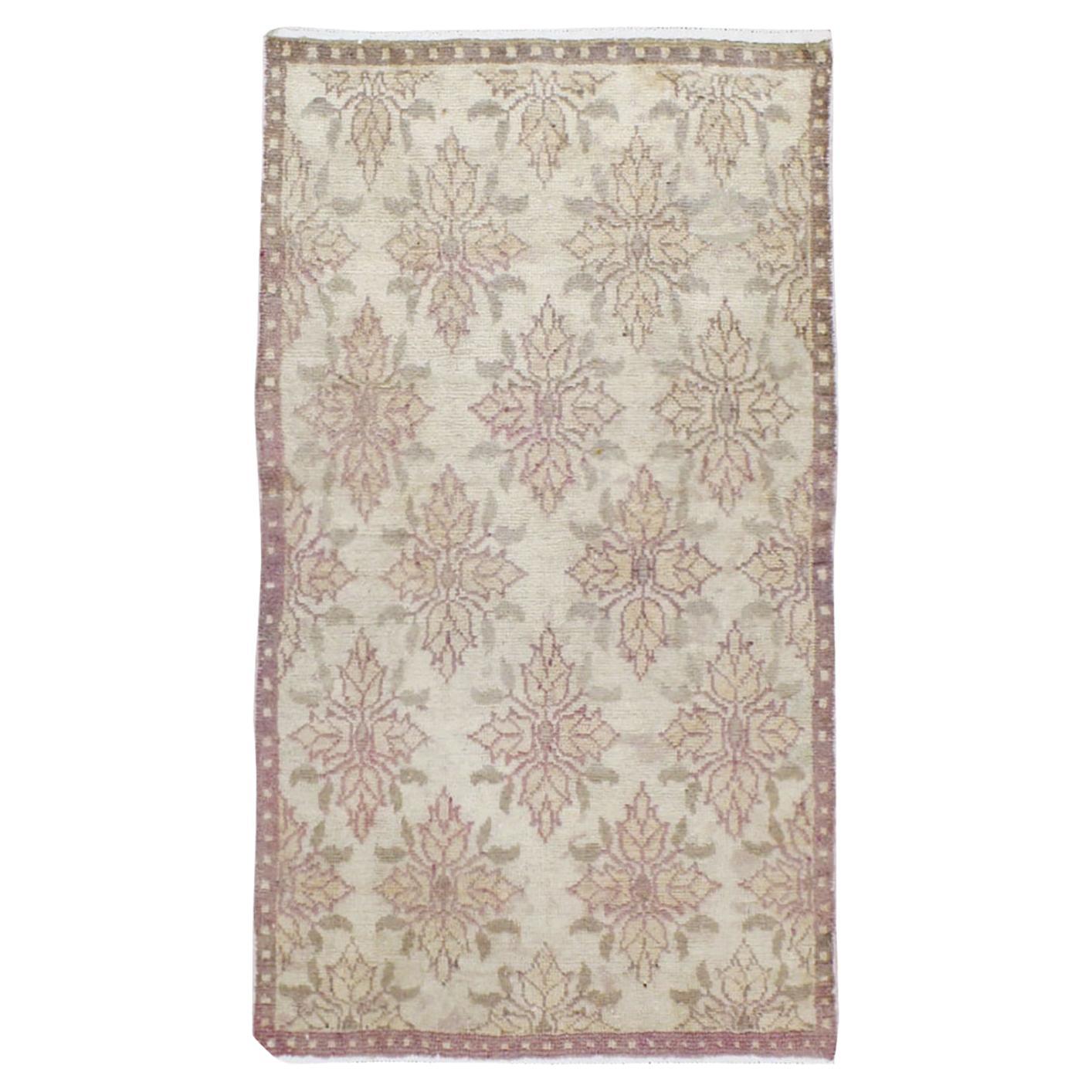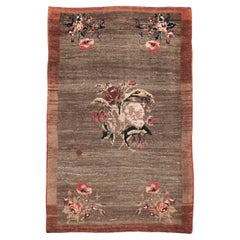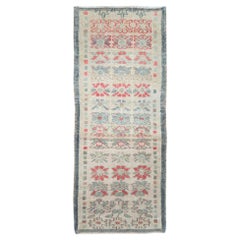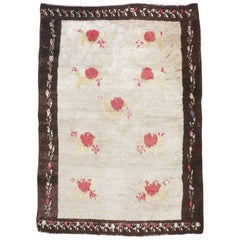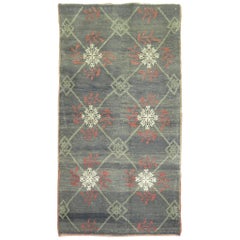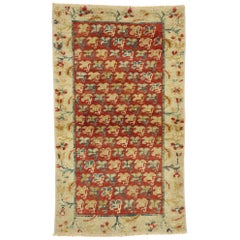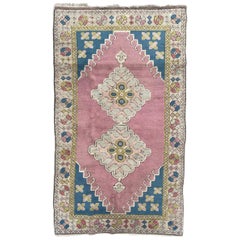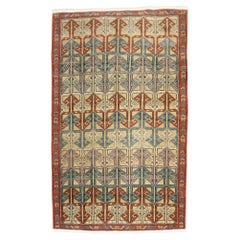Items Similar to Galerie Shabab Collection Mid-20th Century Turkish Anatolian Throw Rug
Want more images or videos?
Request additional images or videos from the seller
1 of 7
Galerie Shabab Collection Mid-20th Century Turkish Anatolian Throw Rug
$1,750
£1,317.59
€1,530.86
CA$2,464.02
A$2,745.10
CHF 1,440.12
MX$33,528.55
NOK 18,234.64
SEK 17,087.37
DKK 11,426.66
About the Item
This mid-20th century Turkish Anatolian rug, measuring 2' 10" x 3' 10", presents a charming floral lattice design infused with folk-art character. The ivory-toned field is organized into a repeating trellis pattern formed by interconnected bows in deep indigo, creating a series of diamond-shaped compartments. Within each compartment, stylized blossoms in shades of crimson, rose, and soft pink emerge, accompanied by green leaves and subtle blue accents. The rhythmic repetition of the floral sprays gives the piece a harmonious balance, while the hand-drawn, slightly varied execution of the motifs adds a lively, artisanal quality. The design’s openness allows the individual flowers to stand out vividly against the light background, and the absence of a heavy border enhances its fresh, airy appearance. This rug reflects the Anatolian tradition’s ability to merge decorative simplicity with vivid color contrasts, making it an appealing accent for both rustic and contemporary interior settings.
About the Seller
5.0
Platinum Seller
Premium sellers with a 4.7+ rating and 24-hour response times
Established in 1989
1stDibs seller since 2009
598 sales on 1stDibs
Typical response time: <1 hour
- ShippingRetrieving quote...Shipping from: New York, NY
- Return Policy
Authenticity Guarantee
In the unlikely event there’s an issue with an item’s authenticity, contact us within 1 year for a full refund. DetailsMoney-Back Guarantee
If your item is not as described, is damaged in transit, or does not arrive, contact us within 7 days for a full refund. Details24-Hour Cancellation
You have a 24-hour grace period in which to reconsider your purchase, with no questions asked.Vetted Professional Sellers
Our world-class sellers must adhere to strict standards for service and quality, maintaining the integrity of our listings.Price-Match Guarantee
If you find that a seller listed the same item for a lower price elsewhere, we’ll match it.Trusted Global Delivery
Our best-in-class carrier network provides specialized shipping options worldwide, including custom delivery.More From This Seller
View AllGalerie Shabab Collection Mid-20th Century Turkish Anatolian Throw Rug
Located in New York, NY
A vintage Turkish Anatolian throw rug. The ivory field displays a brown cartouche lattice which starts a bit uncertainly at the lower corners but quickly gains graphic confidence. Th...
Category
Mid-20th Century Turkish Rustic Turkish Rugs
Materials
Wool
Galerie Shabab Collection Mid-20th Century Turkish Anatolian Throw Rug
Located in New York, NY
This mid-20th century Turkish Anatolian rug, measuring 3' 4" x 5' 1", showcases a striking minimalist composition rooted in village weaving traditions. Set against a deep, variegated...
Category
Mid-20th Century Turkish Rustic Turkish Rugs
Materials
Wool
Galerie Shabab Collection Mid-20th Century Turkish Anatolian Throw Rug
Located in New York, NY
A vintage Turkish Anatolian throw rug handmade during the Mid-20th century.
Measures: 2' 4" x 5' 4"
Category
Mid-20th Century Turkish Rustic Turkish Rugs
Materials
Wool
Mid-20th Century Handmade Turkish Anatolian Throw Rug
Located in New York, NY
A vintage Turkish Anatolian throw rug handmade during the mid-20th century.
Measures: 3' 6" x 4' 11"
Turkish Rugs & Carpets:
Until the Great Persian Carpet Revival in the later 19th century, the “Oriental rug” was Turkish. For nearly six centuries, Turkish rugs, both scatter, room size, and even larger, thoroughly dominated the European import market. Whereas the Persian carpet can be divided into urban, village, and tribal types, in Turkey and its predecessor the Ottoman Empire, rugs almost exclusively came from village weavers and from a small number of urban workshops. Ninety percent village, nine percent city, one percent tribal.
Turkish weavers have, with very few exceptions, always worked with the symmetric (Turkish) knot. Wool foundations are standard practice among both town and village weavers. The exceptions, very finely woven 20th century and recent Herekeh silks from near Istanbul, and early 17th century Ottoman Court rugs from Bursa, constitute only a tiny part of the total. Always pricey, they appealed and still appeal to the clients who want lots of knots and perfect execution instead of individual personality.
The urban workshops have been centered around the western Turkish city of Oushak and its attendant port town of Smyrna. Oushak weaves with the trends in fashion. When color saturated medallion carpets were needed, Oushak was ready in the 17th and 18th centuries. When coarse red and blue carpets were required, Oushak and Smyrna in the 19th century wove them by the boatload. When tastes changed again, and the European dealers in Smyrna wanted room size carpets with lighter and unusual colors, and with Persianate designs, production ramped up in nearby Oushak. Those antique, all-wool construction turn-of-the-century carpets are still in high demand with designers. Antique carpets with allover, roughly drawn patterns on grounds of shrimp, rust, straw, cream, pale blue, and pale and pea green, hitherto unavailable colors, are in such demand today that contemporary Oushaks have attempted to mimic them with soft palettes, extra-large scale drawing and coarse weaves.
Oushaks woven for the Turkish market, for palaces, houses and mosques were often oversize with large, repeating medallions, all in shades of (Turkey) red, dark blue, light blue-teal, and ivory, with lemon and green accents. Turkey, along with India, invented standard sizes. By vertically repeating the medallion, one could get one medallion, one with two end halves, two, three, etc. medallions, up to thirty or so feet in length. The process spared making new cartoons for each length and allowed a quicker turnaround time. Oushak, from the time of 15th century “Holbein” rugs onward, has always been a commercial center.
The prayer niche directional rug is primarily a Turkish development. In the towns and villages east of Oushak, in Ghiordes, Kula, Ladik, Kirsehir, Mucur and Konya, among others, arch pattern scatters with bright palettes and weaves varying from relatively fine to moderate were almost the entire production. Antique examples were particularly popular in America around 1900.
Other centers of village weaving were situated on the western coast and adjacent islands with the town of Melas and neighboring villages weaving geometric prayer rugs and scatters with a characteristic khaki green and lots of yellow.
The other large region was in the northwest of Anatolia, near ancient Troy, with the sizable town of Bergama at its center. The satellite towns of Ezine, Karakecilli, Yuntdag, and Canakkale all wove colorful scatters with moderate weaves in all wool with geometric designs and cheerful palettes. Near to Istanbul, these were among the first Turkish rugs to reach Europe in the Renaissance.
The earliest Turkish pieces depicted in Italian Old Master paintings display the so-called “Memling gul”, an allover panel pattern with hooked and stepped elements within the reserves. This pattern continues for centuries in the Konya area and in the Caucasus as well.
Turkey is a land of villages and much of the most interesting Turkish weaving comes from one undiscovered village or another. The Konya-Cappadocia region of central Turkey includes the active towns of Karapinar, Karaman, Obruk, Sizma, and Tashpinar, all weaving Konya-esque scatters and long rugs. Karapinar has been active the longest, since the 17th century. The mosques in and around Konya have preserved locally-made rugs from the fourteenth. In the 20th century, the extra-long pile, many wefted Tulu rug was devised, with limited palettes and color block patterns. These are not really antique Tulus, but they must be a product of long-standing village tradition.
There are thousands upon thousands of rural Turkish villages, almost all with easy access to local tribal wool. Rug students are discovering new names and rug types almost daily. The common denominators are bright colors, geometric designs, wool construction, moderate to coarse weaves and symmetric knots. Synthetic dyes hit the Turkish rug industry quickly and hard after 1870, and they penetrated to even the most off-the-beaten-track villages. This development was almost entirely negative. The village weavers used fugitive or overly bright dyes which ruined the color harmonies built up over centuries. Characteristic types disappeared or were negatively transmuted. The Turkish village rug of the 1870 to 1920 period is nothing to be proud of.
In the eastern provinces, the semi-nomadic Kurdish tribes, collectively called ‘Yuruks’, weave all wool, geometric pieces with medium to medium-coarse weaves, as well as kilims and other flatweaves. The rugs employ cochineal instead of madder for the reds, mustard yellows, greens, and various blues. They are under-collected like the Persian Afshars. Their rugs are in scatter and long rug formats. The far eastern Turkish town of Erzerum has a long tradition of idiosyncratic, semi-workshop rugs and further to the east is Kars with a tradition of rugs in the Caucasian Kazak manner.
One Turkish specialty is the Yastiks or cushion cover, made in pairs for the public living rooms of village houses. These are larger rugs in miniature and good ones are highly collectible. Like other Turkish rustic weavings, ones with synthetic dyes are almost totally undesirable. Only the tribal Baluch make similar cushion covers, known as pushtis or balishts, in the same small, oblong format. Yastiks always have a back, usually in plain weave, so that they can be easily stuffed.
When the Imperial Carpet Factory at Herekeh near Istanbul closed in the early 20th century, the highly proficient Armenian master weavers set up in the Kum Kapi district of Istanbul where they wove all-silk, exquisitely fine and elaborately detailed small pieces, sometimes enriched with metal thread, for the most discriminating European buyers. Today the best, signed Kum Kapi pieces, usually in the “Sultan’s head” prayer niche design, can fetch upwards of $100,000. They are strictly for the wall. An Interwar all-silk room size Kum Kapi carpet is both exceedingly rare and stratospherically priced. The workshops closed in the 1930s, but the weaving of extremely fine, all-silk small rugs in Herekeh was revived in the 1960s.
There has been a recent vogue for larger Turkish village vintage...
Category
Mid-20th Century Turkish Rustic Turkish Rugs
Materials
Wool
Galerie Shabab Collection Mid-20th Century Turkish Anatolian Throw Rug
Located in New York, NY
This Mid-20th century Turkish Anatolian rug, measuring 3' 1" x 5' 9", presents a charming floral design that blends tradition with a touch of romantic elegance. The rug features a wa...
Category
Mid-20th Century Turkish Rustic Turkish Rugs
Materials
Wool
Mid-20th Century Turkish Anatolian Throw Rug
Located in New York, NY
A vintage Turkish Anatolian throw rug. A taupe and beige dot pattern narrow border frames the oyster field of this Anatolian village scatter with its half-drop rows of four bud quatr...
Category
Mid-20th Century Turkish Rustic Turkish Rugs
Materials
Wool
You May Also Like
Zabihi Collection Vintage Turkish Konya Small Rug
Located in New York, NY
A Mid-century Turkish Konya throw rug.
2'10'' x 5'1''
Category
Mid-20th Century Turkish Bessarabian Turkish Rugs
Materials
Wool
Distressed Vintage Turkish Oushak Rug with Modern Rustic Northwestern Style
Located in Dallas, TX
52096, distressed vintage Turkish Oushak rug with Modern Rustic Northwestern style. Down-to-earth vibes and rustic sensibility meet Pacific Northwest style in this hand knotted wool ...
Category
Mid-20th Century Turkish Oushak Turkish Rugs
Materials
Wool
$1,439 Sale Price
20% Off
Beautiful Vintage Turkish Kars Rug
Located in Saint Ouen, FR
Beautiful mid century Turkish rug with a geometrical Kazak design and beautiful colors with pink, entirely hand knotted with wool velvet on wool foundation.
✨✨✨
"Experience the epit...
Category
Mid-20th Century Turkish Kazak Turkish Rugs
Materials
Wool
$1,141 Sale Price
20% Off
Vintage Turkish Anatolian Scatter Rug
Located in New York, NY
Mid-20th-century Turkish Anatolian scatter size Rug
Size: 3'7'' x 5'7''
Category
Mid-20th Century Turkish Country Turkish Rugs
Materials
Wool
Zabihi Collection Beautiful Floral Turkish Kars Rug
Located in New York, NY
3rd quarter of the 20th Century Turkish Kars rug with an all over floral design on an ivory field
Measures: 5'7'' x 8'1''
Category
20th Century Turkish Arts and Crafts Turkish Rugs
Materials
Wool
Distressed Turkish Sivas Accent Rug with Rustic English Traditional Style
By Zeki Müren
Located in Dallas, TX
51898, distressed Turkish Sivas Accent rug with Rustic English Traditional style. Lovingly timeworn with understated elegance, this...
Category
Mid-20th Century Turkish Arts and Crafts Turkish Rugs
Materials
Wool
$439 Sale Price
20% Off
